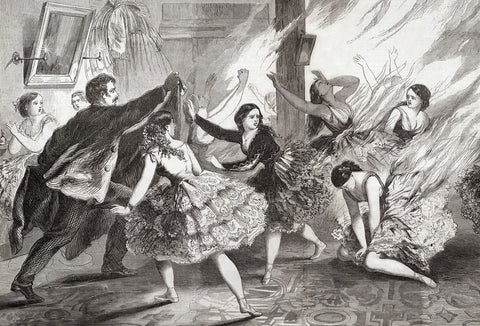The Middle Ages were known for a variety of things: gothic architecture, chivalrous knights (and not-so-chivalrous ones), grand castles and cathedrals... and a veritable smorgasbord of terrible endemic illnesses. To compound the problem, sicknesses ran rampant at a time where treatment and cures often made matters worse.
You're likely familiar with the infamous bubonic plague or Black Death, which killed 1/3 of all Europeans, and possibly also with more quotidian illnesses like syphilis and cholera. However, there is a lesser-known ailment that is much weirder. An illness that caused extreme convulsions and paranoia and religious delusions, and is caused by eating contaminated bread.
It’s not actually the bread that is the culprit, but Claviceps purpurea, an ascomycete ergot fungus that can infect different types of cereal grain, particularly rye. The fungus spread amongst the healthy rye, and farmers would harvest their crops, none the wiser to the infection, The grains would then be taken from field to kitchen to be baked into an otherwise perfect loaf of bread.
Once consumed, the fungus in the rye caused a sickness that medieval Europeans called "St. Anthony’s Fire".

Central panel of The Temptation of St Anthony by Hieronymus Bosch, c. 1505
So what happens to the infected?
The symptoms of St. Anthony's Fire - or what modern medicine calls "ergotism", after the type of fungus that causes it - range from muscle spasms, headaches, nausea and convulsions to horrifying or fantastical delusions and paranoia. Those infected often described a feeling of something crawling under their skin, while others fell victim to vivid hallucinations. A common element? Religious fanaticism and visions.
The illness was not contagious, but entire households were known to get sick at the same time, presumably from consuming the fungus together over the course of a meal. Family dinner became a dangerous affair.
Ergotism in the New World
Ergotism followed Europeans everywhere they went with their cereal grains, including to North America. And there, the medieval European fear of witchcraft may have combined with ergotism to fuel the Salem Witch Trials in Massachusetts less than a hundred years after the first settlers came over on the Mayflower.
In 1692, Betty Parish and Abigail Williams of the small village of Salem, Massachusetts were diagnosed as "bewitched" after they both showed signs of severe convulsions, along with other strange behavioural symptoms. Soon, there was the first true witch-hunt in North America, with accusations of witchcraft leveled at nearly any woman who could potentially have been a witch (meaning, women who defied in any way the Puritan standards of the village and the time). But perhaps there wasn’t a sudden surge of witches and magic in the area; perhaps it was simply a bad crop.
The village doctor wouldn’t have had the knowledge to diagnose ergotism at that time; the link between ergot fungus and illness was not discovered until the 19th century. And attributing such madness to witchcraft was an easy accusation, especially in a small religious village where Puritan principles and superstition were the dominant ideologies.
Which begs the question:
What other common phenomena do we think we understand - but are actually caused by something both totally unknown and utterly ordinary?
(Are you fascinated by very strange historical deaths under odd circumstances? Try our Post-Mortem series of mystery adventures.)



